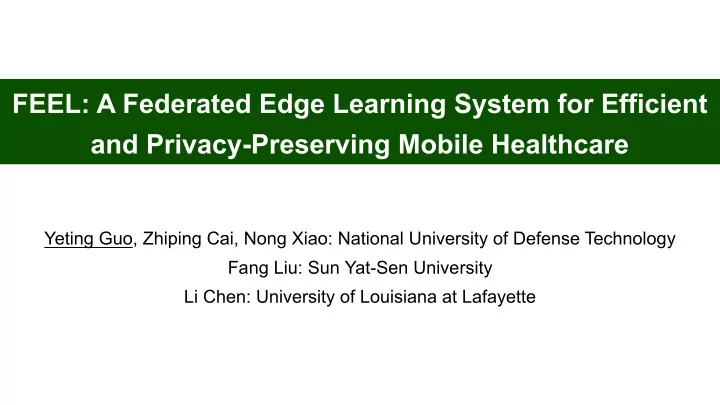

FEEL: A Federated Edge Learning System for Efficient and Privacy-Preserving Mobile Healthcare Yeting Guo, Zhiping Cai, Nong Xiao: National University of Defense Technology Fang Liu: Sun Yat-Sen University Li Chen: University of Louisiana at Lafayette
AI enables smart healthcare The scale of smart medical market is rapidly growing. … Drug Research Diagnosis of Disease Chronic disease prediction
Challenge 1: Medical records face serious security breach 2,550 data breaches have compromised over 189 million healthcare records in the last decade. (Source: HIPAA Journal) The average cost of a data breach in the healthcare industry is $6.45 million. (Source: IBM) 46% of healthcare organizations have been damaged by insider threats . (Source: 2019 Verizon Insider Threat Report) 168 hacking incidents in the first half of 2019 has led to 31 million breached records . (Source: Protenus Breach Barometer)
Challenge 2: Mobile medical devices are resource-limited MOTO 360 smartwatch: Memory 512MB , Storage 4GB , 320mAh battery Huawei GT 2e smartwatch: Memory 16MB , Storage 4GB , 455mAh battery As neural network training is extremely computation-intensive, it easily drains the battery and starves the normal operations of the device . Training on mobile wearables is inefficient.
What makes a good mobile healthcare system? High accuracy Privacy Efficiency preservation
Contributions 1. Efficient health monitoring and model training 2. Accurate diagnosis without raw data leakage 3. Study on privacy and performance High accuracy Privacy Efficiency preservation
Contributions 1. Efficient health monitoring and model training 2. Accurate diagnosis without raw data leakage 3. Study on privacy and performance High accuracy Privacy Efficiency preservation
Edge-based efficient medical model training and health monitoring noised output of the middel layers data labels gradient of loss to noised output ' O , L k j ▽ ' Lo ss(O ) k
Setup -- Experiment Platform LAN mobile device hospital server WAN cloud center
Setup -- Dataset and Training Models Dataset We leverage breast cancer data as the private medical data set, which contains 497 training samples and 151 testing samples Training Model Our loss function is binary-cross-entropy, and compilation environment is Keras [1] Olvi L Mangasarian and William H Wolberg. 1990. Cancer diagnosis via linear programming. Technical Report. University of Wisconsin- Madison Department of Computer Sciences. https://archive.ics.uci.edu/ml/machine-learning-databases/ breast- cancer- wisconsin/
Results -- Resource Consumption 78.39% 45.90% 20.77%, 45.57% Traditional learning Offloading total model to edge paradigm without without privacy consideration efficiency consideration Our best practice
Contributions 1. Efficient health monitoring and model training 2. Accurate diagnosis without raw data leakage 3. Study on privacy and performance Privacy Efficiency preservation
Privacy-preserving medical model aggregation W center W server
Setup -- Dataset and Distribution Dataset We leverage breast cancer data [1] as the private medical data set, which contains 497 training samples and 151 testing samples Distribution We distribute these training samples among 100 hospitals. Considering that the user data are not independent and identically distributed in multiple hospitals, we distribute these samples with following existing works [2]. [1] Olvi L Mangasarian and William H Wolberg. 1990. Cancer diagnosis via linear programming. Technical Report. University of Wisconsin- Madison Department of Computer Sciences. https://archive.ics.uci.edu/ml/machine-learning-databases/ breast- cancer- wisconsin/ [2] Robin C. Geyer, Tassilo Klein, and Moin Nabi. 2017. Differentially Private Federated Learning: A Client Level Perspective. CoRR abs/1712.07557 (2017). arXiv:1712.07557 http://arxiv.org/abs/1712.07557
Results -- Diagnosis Performance Centralized Learning (Best performance but no privacy protection ) Stand-alone Learning (Strong privacy protection but poor performance) Federated learning ( ) Stand-alone learning ( )
Contributions 1. Efficient health monitoring and model training 2. Accurate diagnosis without raw data leakage 3. Study on privacy and performance Efficiency
Privacy-preserving differential privacy scheme
Results -- Sensitivity of σ1 and σ2 The performance gradually decreases with the increase of noise level. Considering both privacy and performance, we select σ1 and σ2 as 0.5 and 2.25, respectively.
Conclusion Problem : Address the inefficient and insecure scheme in mobile medical data training. Key idea : FEderated Edge Learning (FEEL) system Evaluation : FEEL reduces the mobile devices' resource occupation (CPU time, memeory, energy et al.) and performs near optimal with privacy protection.
Thank You! guoyeting13@nudt.edu.cn FEEL: A Federated Edge Learning System for Efficient and Privacy-Preserving Mobile Healthcare Yeting Guo, Fang Liu, Zhiping Cai, Li Chen, Nong Xiao
Recommend
More recommend